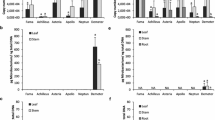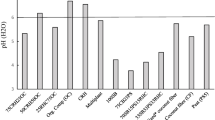Abstract
A high incidence ofin vitro bacterial contamination (69%) has been detected in meristem-tip explants ofHydrangea from widely differing locations in Ireland and the UK. The bacteria were characterised by API 20E biochemical test kits and by fatty acid profile analysis. The results obtained from the different methods were compatible and anomalies were explicable in terms of the limitations of the respective methods. The majority of the isolates were environmental or animal-associated bacteria with clusters ofEnterobacter isolates in Dublin, and ofEscherichia coli in the main Cork location. A cluster of Pseudomonads was detected in the Derby (UK) plants. The main association was between the location and the contaminant clusters. The main finding was that the nature of organic soil amendments may influence inoculum for the contamination of plants and the conclusion was that fertilisation with organic materials should be avoided in the preparation of plants for micropropagation.
Similar content being viewed by others
References
Bailey D A (1992) Hydrangeas. In: Larson RA (ed) Introduction to Floriculture (pp 365–383). Academic Press, London, UK
Barrett C & Cassells A C (1994) An evaluation of antibiotics for the elimination ofXanthomonas campestris pv.pelargonii (Brown) fromPelargonium xdomesticum cv. “Grand slam” explantsin vitro. Plant Cell Tiss. Org. Cult. 36: 169–175
Boxus Ph & Terzi J M (1987) Big losses due to Bacterial contaminations can be avoided in mass propagation scheme. Acta Hortic. 212: 91–93
Bradbury J F (1988) Identification of cultivable bacteria from plants and plant tissue cultures by use of simple classical methods. Acta Hortic. 225: 27–37
Cassells A C (1988) Bacterial and Bacteria-like Contaminants of Plant Tissue Cultures. Acta Hortic (p 225)
Cassells A C (1991) Problems in tissue culture: Culture contamination. In: Debergh P C & Zimmermann R H (eds) Micropropagation Technology and Application (pp 31–44). Kluwer Acad. Publishers. Dordrecht, The Netherlands
Cassells A C (1992) Screening for pathogens and contaminating micro-organisms in micropropagation. In: Duncan J M & Torrance L (eds) (pp 179–192). Blackwell, Oxford, UK
Cassells A C (1996)In vitro production of pathogen and contaminant free plants. In: Altman A (ed) Agricultural Biotechnologies: Principles and Practices. Plenum, New York, USA (in press)
Combes A J & Gardner P H B (1991) Hillier Manual of Trees and Shrubs (1991) 6th edition, David & Charles, London, UK
Debergh P C & Maene L J (1981) A scheme for commercial propagation of ornamental plants by tissue culture. Scientia Hortic. 14: 335–345
Gardan L & Dorkar S G (1985) Observation of Hydrangea bud blight caused byPseudomonas viridiflava (Burkholder) Dowson. Rev. Hortic. 253: 48–49
Gunson H E & Spenser-Phillips P T N (1994) Latent bacterial infections: epiphytes and endophytes as contaminants of micropropagated plants. In: Lumsden P J, Nicholas J R & Davies W J (eds) Physiology, Growth and Development of Plants in Culture (pp 379–396). Kluwer Acad. Publishers, Dordrecht, The Netherlands
Harley J P & Prescott L M (1993) Laboratory Exercises in Microbiology. Wm. C. Brown Publ., Philadelphia, USA
Hayward A C (1974) Latent infections by bacteria. Ann. Rev. Phytopathol. 12: 87–97
Leggatt T V, Waites W M, Leifert C & Nicholas J (1988) Characterization of microorganisms isolated from plants during micropropagation. Acta Hortic. 225: 93–102
Leifert C, Waites W M & Nicholas J R (1989a) Bacterial contaminants of micropropagated plant cultures. J. Appl. Bacteriol. 67: 353–361
Leifert C, Waites W M, Camotta H & Nicholas J R (1989b)Lactobacillus plantarum: a deleterious contaminant of plant tissue cultures. J. Appl. Bacteriol. 67: 363–370
Leifert C & Waites W M (1994) Dealing with microbial contaminants in plant tissue and cell culture: hazard analysis and critical control points. In: Lumsden P J, Nicholas J R & Davies W J (eds) Physiology, Growth and Development of Plants in Culture (pp 363–378). Kluwer Acad. Publishers, Dordrecht, The Netherlands
Lelliott R A & Stead D E (1987) Methods for the Diagnosis of Bacterial Diseases of Plants. Blackwell, Oxford, UK
Mallet C, Mallet R & Van Trier H (1992) Hydrangeas: Species and Cultivars. Vol 1. Centre d'art Floral, Editions Robert Mallet, Varengeville sur mer, France
Mallet C (1994) Hydrangeas: Species and Cultivars. Vol 2. Centre d'Art Floral, Editions Robert Mallet, Varengeville sur mer, France
Murashige T & Skoog F (1962) A revised medium for rapid growth and bioassays with tobacco tissue cultures. Plant Physiol. 15: 473–497
Schaad N W (1988) Laboratory Guide for the Identification of Plant Pathogenic Bacteria. 2nd edition. APS Press, St Paul, Minnesota, USA
Stead D E (1992) Techniques for detecting and identifying plant pathogenic bacteria. In: Duncan J M & Torrance L (eds) (pp 76–114). Blackwell, Oxford, UK
Stolz L P (1984)In vitro propagation and growth ofHydrangea. HortScience 19: 717–719
Author information
Authors and Affiliations
Rights and permissions
About this article
Cite this article
Cassells, A.C., Tahmatsidou, V. The influence of local plant growth conditions on non-fastidious bacterial contamination of meristem-tips ofHydrangea culturedin vitro . Plant Cell Tiss Organ Cult 47, 15–26 (1996). https://doi.org/10.1007/BF02318961
Received:
Accepted:
Issue Date:
DOI: https://doi.org/10.1007/BF02318961




